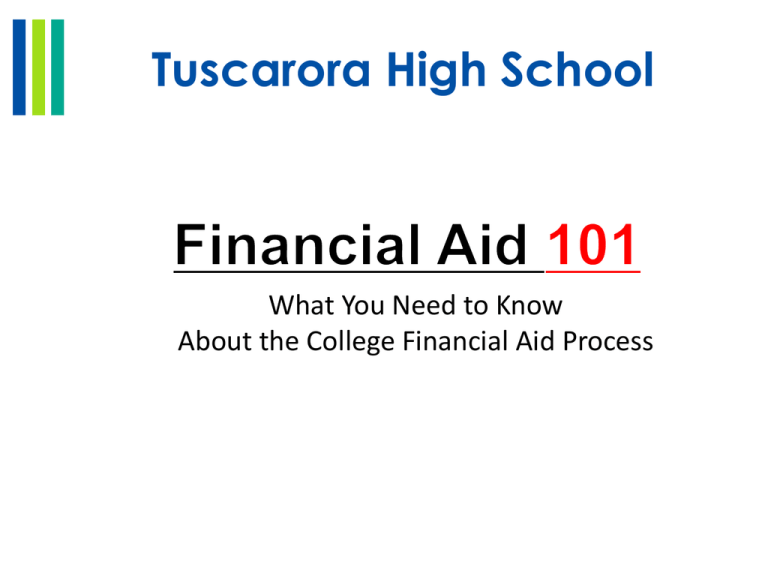Tuscarora High School What You Need to Know
advertisement

Tuscarora High School What You Need to Know About the College Financial Aid Process Topics • • • • • • • • What is Financial Aid? Need Components Types of Aid Applying for Aid Dependency Status and Parents Effect of Outside Aid Change in Circumstances What’s Next? What is financial aid? Financial aid consists of funds provided to students and their families to help pay for postsecondary education. Financial aid helps to bridge the gap between the Cost of Attendance and the Expected Family Contribution. What is Cost of Attendance (COA)? Other Room and Board Books Tuition and Fees Travel Personal Varies based on the school What is Expected Family Contribution (EFC)? • Amount a family can reasonably be expected to contribute • Two Components – Parent Contribution + Student Contribution • Calculated using data from the FAFSA • Does not change based on the school Financial Need Calculation Cost of Attendance – Expected Family Contribution = Financial Need Where does financial aid come from? • • • • Federal government State government College/University Private sources Types of Financial Aid • • • • Scholarships Grants Work-study Loans Scholarships • Money that does not have to be paid back • Usually based on merit, skill, a unique characteristic, and/or need • Sources – Civic organizations, churches, employers, schools • Free online web searches – www.fastweb.com – https://bigfuture.collegeboard.org/scholarship-search • CAUTION – Beware of scams – http://www.finaid.org/scholarships/protecting.phtml Grants • Money that does not have to be paid back, some may require an “agreement to serve” after graduation • Typically based on financial need • Federal Grants – Federal Pell Grant, Federal Supplemental Education Opportunity Grant (FSEOG), Teacher Education Assistance for College and Higher Education Grant (TEACH) • State Grants – Virginia Guaranteed Assistance Program, Commonwealth Award, Virginia Tuition Assistance Grant Work-study • Allows student to earn money to help pay for college costs • On and off-campus jobs available • Paid by: – Paycheck – Credit to student account – Non-monetary compensation Example: Room and Board (resident assistants) • Not all colleges participate Loans • Money that is borrowed to finance educational costs, which must be repaid • Borrower - Student and/or Parent • Repayment – Student - After graduating or dropping below half-time enrollment – Parent - Typically 60 days after the first disbursement or can request deferment while student is enrolled at least half-time (interest accrues while deferred) – Repayment terms and options vary for students and parents Loans Common Federal Loan Programs • Federal Perkins Loan – fixed 5% interest rate • Federal Direct Student Loan – Subsidized – fixed 3.4% interest rate, interest does not accrue while in school, based on need – Unsubsidized – fixed 6.8% interest rate, interest accrues while in school, but does not require in-school repayment on interest, not based on need • Federal Parent PLUS Loan – fixed 7.9% interest rate, one parent borrower, good credit history FAFSA Process Complete the Free Application for Federal Student Aid (FAFSA) each year. • • • • • Available January 1 of each year at www.fafsa.gov Check with colleges for any priority deadlines File electronically for faster processing and online tracking Collects demographic and financial information If “Will File”, you can provide estimated tax information, but will need to update once taxes have been filed • Information collected is used to determine EFC • Apply for PIN (Personal Identification Number) • Student and parent sign with their own PIN PIN Process • Student and parent each apply for a personal identification number (PIN) at www.pin.ed.gov • Can be requested at any time, even real-time as the student completes the online FAFSA • Must have PIN to electronically sign the FAFSA • PIN can be used to sign loan master promissory note (MPN) General Student Criteria • • • • U.S. citizen or eligible non-citizen Registered with Selective Service (males) Valid Social Security Number (SSN) High school diploma, GED, or homeschooling credential • Enrolled or accepted in an eligible degree or certificate program • Criminal convictions (including drug convictions) may limit eligibility, depends on the conviction and type of institution Dependency Status FAFSA will ask a series of questions to determine if the student is dependent or independent, including: • • • • • • 24 years or older Married Master’s or doctorate degree program Military service – Active or Veteran Children and/or dependents, provide half of support Foster care, deceased parents, dependent or ward of court, emancipated minor or legal guardianship, homeless * If all “No” answers, student is dependent. * If “Yes” to any question, student is independent. Who is the ‘parent’? • Biological parents information or adoptive parents should be provided on the FAFSA • Grandparents, legal guardians, foster parents, older brothers or sisters, and uncles or aunts are not considered parents on the FAFSA unless they have legally adopted you • Possible dependency override in certain circumstances – rare, but speak with your financial aid administrator Which parent? In cases of divorce or separation: • Who did the student live with the most during the past 12 months? • If neither or both, who provided the most financial support? – Example: Who paid for health or car insurance? Household Size • • • • Student Parents Dependents Others who live with you and you are providing more than half of their support and will continue to provide from July 1 – June 30 Errors can be costly! • Read instructions and complete carefully! Incorrect or missing information may delay the process and result in loss of financial aid • Most Common Errors – Social Security Numbers – Divorced/remarried parental information – Income earned/paid and untaxed income – Household size and number of household members in college – Real estate and investment net worth IRS Data Retrieval Tool (DRT) • Applicants have the option to transfer IRS tax data into their FAFSA using the DRT • DRT allows the applicant to file more quickly and accurately, saving up to 8 weeks – File taxes electronically and early, then file your FAFSA using the IRS DRT after 10-14 days • Not eligible for IRS DRT? – Complete based on 2012 tax return and order an IRS transcript of any 2012 tax returns filed at www.irs.gov Verification • At least one in three applications may be selected by a school • Did not use the IRS DRT and are selected for verification? You must submit an IRS Transcript • Contact your financial aid office about any other documentation needed for the verification process • Financial aid cannot be released to a student’s account until this step is completed Role of the College Financial Aid Office • Assists students and their families in understanding and utilizing financial aid resources • Determines federal and state aid eligibility • Verifies FAFSA information • Reviews special circumstances • Packages financial aid depending on fund availability • Sends award notification (electronic or paper) with award amounts, disbursement methods, timeframes, and any terms and conditions of each award Outside aid vs. Award package • Notify school of all outside/private scholarships and grants • Could result in a change to need-based aid if the outside aid causes you to exceed your financial need or COA Student Aid Example Cost of Attendance $24,000 EFC $4,000 Grants $6,000 Work-study $4,000 Loans $6,000 Outside award #1 $2,000 Outside award #2 $1,000 Outside award #3 $3,000 Student Aid Example, Cont. • Since the student submitted a letter to the Financial Aid Office confirming an additional $6,000 in outside aid, the Financial Aid Office must reduce other aid to keep the student within their $24,000 cost of attendance • Typically schools will reduce loans first since they require repayment • A revised award notice will be sent to the student Change in Circumstances • • • • Loss of income or benefit Death of a parent Parent divorced or separated after FAFSA is filed Unusually high medical expenses paid but not reimbursed by insurance You may be eligible for adjustment based on professional judgment - speak with your financial aid administrator What’s Next? • After FAFSA processing, student will receive a Student Aid Report (SAR) via link in email if student provided valid email address or paper by mail if no valid email address provided • Review SAR comments and check for accuracy • Remember to update any estimated information • Make sure you meet all admissions and financial aid deadlines. Check each school’s website for details • Submit any requested documents • Search and apply for other sources of aid, such as private scholarships and grants Summary • • • • • • • • Start the process early Know any and all deadlines Know what information and forms you need Provide accurate information Make and save copies of everything Follow up: typical processing times are 4-6 weeks Check your email regularly If you have a question – ASK! Saturday February 10-2pm th 14 What is Super Saturday? • FREE assistance completing the FAFSA (Free Application for Federal Student Aid) • Financial Aid presentations • Chance to win a $100 book scholarship Who should attend? High school, college, and adult students who plan to attend college during the 2015-2016 academic year www.vasfaa.org Questions? Good Luck and Thank You for participating in Our Financial Aid Workshop
